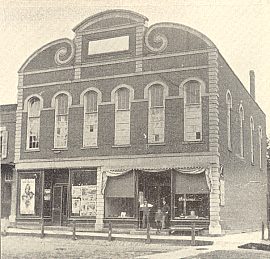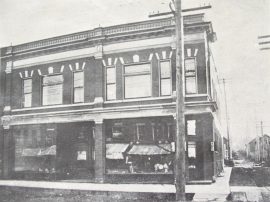
Photo by D. W. Ellis from Picturesque Anamosa, compiled and published by W. Leon Hall, Cedar Rapids, Iowa, ca. 1900, and provided by Lois O'Donnell |
Now it's time to cross Main street and head east, starting with the unique "Old" Opera House at the southeast corner of Main and Garnavillo. The History of Jones County, Iowa, Chicago: Western Historical Company, 1879, p. 559, and the Portrait and Bigraphical Record of Dubuque, Jones, and Clayton Counties, Chapman Publishing Co., 1894, both indicate that E. C. Holt built and owned this structure. However A Guide to Historic Main Street Anamosa, 1992, Fourth Street Publishing, the contractor was actually Henry Lehmkuhl, who brought in a architect to design the facade. The building was dedicated with a ball on December 13, 1867.
The opera house was on the second story which was later used as a dance hall and for amateur theatre productions. W.S. Barker operated a grocery store in the corner of the main floor. In the 1920s, the Dodge Motor Company was located in the building. The 2-story building to the east of the Opera House was constructed by Samuel B. Tucker for his wife's millinery about 1866. Lucy Tucker imported her goods from Chicago and employed a hairdresser to do curls, puffs and frizzettes. Next is the Hollenbeck Block, built in 1867, by W. W. Hollenbeck. He and his brothers, Harlan and Charles, were business men of that period. The building was divided into three shops. The P. M. Wallace Bakery, a place of high reputation, was there. It later became the Giltrap Bakery when one of the employees bought the enterprise. Later tenants were McNamaras Plumbing and Gene's Quick Lunch. | ||||||
|
Across the alley was the Dubuque Brewing and Malting Company built by John Cartano in 1904. The site had previously been the United Brethren church and the saloon caused uproar among the "drys." The building was later the home of Dutch Westphal's grocery and People's Natural Gas. Going back to the photo at the top of the page, next door to the saloon is the Brunskill Building, built in 1867. It housed Brunskills Butcher Shop and, later, the Sherman Bros. Grocery and Elsie Beam's S. & G. Savings Stamp Parlor. The store with the white awning was Watters and Niles Meat Market. Over the years various partnerships operated the establishment. Later the building housed Cecil Farmer's Tavern. Beyond that was the D. M. Hakes building, built in 1881, as a grocery.
|
 Photo from Souvenir of Anamosa published by The Anamosa Journal, March 28, 1907, and submitted by Jim Christianson |
||||||
| |||||||
